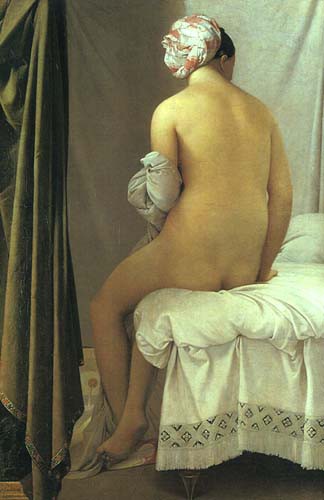Ingres was awarded the Premier prix de Rome in 1801 but had to wait until 1806 before being able to spend four years in Italy. Prize winners were supposed study the works of antiquity and the masterpieces of the Renaissance and then to produce works which would reveal the progress they were making. In 1808, Ingres chose to send to his teachers in Paris a sensuous and intimate scene depicting a woman bathing. Whilst the other work sent at the same time used a painting of Œdipus and the Sphinx (an eminently heroic and moral subject) as a pretext for a male nude, here the Woman seated (the first title for the Woman bathing) has no such alibi. She is naked – although only her back is shown – and on her head she wears a turban. She appears to be washing – past the curtains, the viewer can see a basin with a tap in the form of a lion's head. There is no narrative whatsoever. She simply sits, motionless, anonymous, unfathomable.
The female nude is a permanent feature of western art and the embodiment of classical perfection. Ingres would appear to have been inspired by the work Baigneuse à mi-corps (1807, Musée Bonnat, Bayonne), especially in terms of the harmonious lines and transparency of the flesh tones, but he was also clearly indebted to Tuscan mannerism and the works of Raphael (Ingres' obsession). His portrait here of a nude back view was to fascinate him until the end of his life. Indeed, he reworked it many times, and it was to become the central figure in the painting entitled Turkish bath, commissioned by the Prince Napoléon circa 1848, delivered in 1859 but soon returned to the painter – the Princesse Clotilde had been shocked -, and worked on it until 1863. In the Turkish bath, the Woman bathing has lost her timeless quality, becoming the centre of a harem scene, where she as musician dominates all the other naked bodies in an erotic vision of the Orient.
The Woman bathing was bought by General Rapp when it was presented in Paris in 1808. It was later bought by Valpinçon, who famously gave it his name and infamously refused to loan it for the great retrospective exhibition of Ingres' works at the Universal Exhibition of 1855. It was only the invention of the young Degas, a huge admirer of Ingres, which made Valpinçon change his mind. The next owner of the painting, the banker Isaac Pereire, was to sell the work to the Louvre in 1879.
Karine Huguenaud (tr. P.H.)
March 2008
The Woman bathing, known as the Valpinçon woman bathing
Artist(s) : INGRES Jean Auguste Dominique

- Date :
- 1808
- Technique :
- oil on canvas
- Dimensions :
- H = 1.46 m, L = 0.97 m
- Place held :
- Paris, Musée du Louvre
- Photo credit :
- © CGFA

